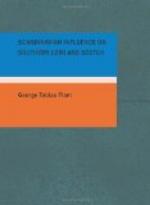2. PLACE-NAMES AND SETTLEMENTS IN NORTHWESTERN ENGLAND.
Cumberland and Westmoreland, together covering an area equal to about two-thirds that of Yorkshire, have 300 Scandinavian place-names. Yorkshire has 407 according to Worsaae’s table. The character of these names in Cumberland and Westmoreland is different from that of those in the rest of England. It seems that these counties were settled predominantly by Norsemen and also perhaps at a later date than that which we accept for the settlements in York and Lincolnshire. We know that as early as 795 Norse vikings began their visits to Ireland; that they settled and occupied the Western Isles about that time; that in 825 the Faroes were first colonized by Norsemen, partly from the Isles. After 870 Iceland was settled by Norsemen from Norway, but in part also from the Western Isles and Ireland. The ‘Austmen’ in Ireland, especially Dublin, seem frequently to have visited the opposite shore. It seems probable that Northwestern England was settled chiefly by Norsemen from Ireland, Man, and the Isles on the west. It is not likely that any settlements took place before 900. It seems more probable that they belong rather to the second quarter of the 10th Century or even later, when the Irish began successfully to assert themselves against the Norse kings in Dublin and Waterford. Perhaps some may have taken place even as late as the end of the 10th Century.
3. SCANDINAVIAN SETTLEMENTS IN SOUTHERN SCOTLAND.
In Southern Scotland, Dumfriesshire, Eastern Kircudbright and Western Roxburgh seem to have formed the center of Scandinavian settlements; so, at any rate, the larger number of place-names would indicate. The dialect spoken here is in many respects very similar to that of Northwestern England, D. 31 in Ellis, and the general character of the place-names is the same. These are, however, far fewer than in Northwestern England. Worsaae gives a list of about 30. This list is not exhaustive. From additional sources, rather incomplete, I have been able to add about 80 more Scandinavian place-names that occur in Southern Scotland, most of them of the same general character as those in Northwestern England. Among them: Applegarth, Cogarth, Auldgirth, Hartsgarth, Dalsgairth, Tundergarth, Stonegarthside, Helbeck, Thornythwaite, Twathwaite, Robiethwaite, Murraythwaite, Lockerby, Alby, Denbie, Middlebie, Dunnabie, Wysebie, Perceby, Newby, Milby, Warmanbie, Sorbie, Canoby, Begbie, Sterby, Crosby, Bushby, Magby, Pockby, Humbie, Begbie, Dinlaybyre, Maybole, Carnbo, Gateside, Glenholm, Broomholm, Twynholm, Yetholm, Smailholm, Langholm, Cogar, Prestwick, Fenwick, Howgate, Bowland, Arbigland, Berwick, Southwick, Corstorphine, Rowantree, Eggerness, Southerness, Boness, etc. There are in all about 110 such place-names, with a number of others that may be either English or Scandinavian. The number of Scandinavian elements in Southern Scotch is, however, very great and indicates larger settlements




